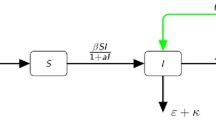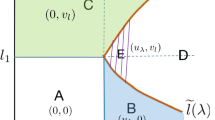Abstract
To study the impact of vector’s habitat expansion and mobility of hosts on the geographic spread of diseases, we propose a diffusive vector–host epidemic model with a finite growing domain and mainly focus on its asymptotic profile. In a situation that the domain grows uniformly and isotropically with growth ratio \(\rho \), we employ the Lagrangian transformations to transform the model in the growing domain into the one in a fixed domain, along with dilution terms and time-dependent diffusion coefficients. We analyze the well posedness of the model and define the basic reproduction number \(\Re _0^\rho \). Our results indicate that if \(\Re _0^\rho < 1\), the disease-free equilibrium is globally asymptotically stable without any extra conditions, while the infected populations will eventually tend to the set formulated by the maximum and minimum solutions of the associated steady-state problem if \(\Re _0^\rho >1\). The analysis is carried out by using the comparison principle, the theory of quasimonotone nondecreasing elliptic and parabolic system, and convergence of abstract asymptotic autonomous system. Comparing the results with those in a fixed domain, we confirm that the growth of domain brings negative influences on disease control.
Similar content being viewed by others
References
Chen, J., Huang, J., Beier, J.C., Cantrell, R.S., Cosner, C., Fuller, D.O., Zhang, G., Ruan, S.: Modeling and control of local outbreaks of West nile virus in the United States. Discrete Contin. Dyn. Syst. Ser B. 21, 2423–2449 (2016)
Bowman, C., Gumel, A.B., van den Driessche, P., Wu, J., Zhu, H.: A mathematical model for assessing control strategies against West Nile virus. Bull. Math. Biol. 67, 1107–1133 (2005)
Ross, R.: An application of the theory of probabilities to the study of a priori pathometry. Proc. R. Soc. Lond A. 92, 204–230 (1916)
Macdonald, G.: The analysis of equilibrium in malaria. Trop. Dis. Bull. 49, 813–829 (1952)
Macdonald, G.: The Epidemiology and Control of Malaria. Oxford University Press, London (1957)
Chamchod, F., Britton, N.F.: Analysis of a vector-bias model on malaria transmission. Bull. Math. Biol. 73, 639–657 (2011)
Fitzgibbon, W.E., Morgan, J.J., Webb, G.F.: An outbreak vector-host epidemic model with spatial structure: the 2015–2016 Zika outbreak in Rio De Janeiro. Theor. Biol. Med. Modell 14, 7 (2017)
Wang, X., Zhao, X.Q.: A periodic vector-bias malaria model with incubation period. SIAM J. Appl Math. 77, 181–201 (2017)
Magal, P., Webb, G.F., Wu, Y.: On a vector-host epidemic model with spatial structure. Nonlinearity 31, 5589–5614 (2018)
Wang, J., Chen, Y.: Threshold dynamics of a vector-borne disease model with spatial structure and vector-bias. Appl. Math. Lett. 100, 106052 (2020)
Bailey, N.T.J.: The Mathematical Theory of Epidemics. Charles Griffin & Company Limited, London (1957)
Dietz, K.: Mathematical models for transmission and control of malaria. In: Wernsdorfer, W., McGregor, I. (eds.) Malaria: Principles and Practice of Malariology. Churchill Livingstone, Edinburgh (1988)
Busenberg, S., Vargas, C.: Modeling Chagas’ disease: variable population size and demographic implications. In Ovide Arino, David E. Axelrod, and Marek Kimmel, editors, Mathematical Population Dynamics, Lecture Notes Pure and Applied Mathematics. Boca Raton:CRC Press; (1991)
Inaba, H., Sekine, H.: A mathematical model for Chagas disease with infection-age-dependent infectivity. Math. Biosci. 190, 39–69 (2004)
Velasco-Hernández, J.X.H.: An epidemiological model for the dynamics of Chaga’s disease. Biosystems 26, 127–134 (2004)
Xu, Z., Zhao, X.Q.: A vector-bias malaria model with incubation period and diffusion. Discrete Contin. Dyn. Syst. Ser. B. 17, 2615–2634 (2012)
Wang, W., Zhao, X.Q.: A nonlocal and time-delayed reaction-diffusion model of dengue transmission. SIAM J. Appl. Math. 71, 147–168 (2011)
Bai, Z., Peng, R., Zhao, X.Q.: A reaction-diffusion malaria model with seasonality and incubation period. J. Math. Biol. 77, 201–228 (2018)
Lou, Y., Zhao, X.Q.: A reaction-diffusion malaria model with incubation period in the vector population. J. Math. Biol. 62, 543–568 (2011)
Allen, L.J.S., Bolker, B.M., Lou, Y., Nevai, A.L.: Asymptotic profiles of the steady states for an SIS epidemic reaction-diffusion model. Discrete Contin. Dyn. Syst. 21, 1–20 (2008)
Peng, R.: Asymptotic profiles of the positive steady state for an SIS epidemic reaction-diffusion model. Part I. J Differ. Equ. 247, 1096–1119 (2009)
Li, B., Li, H., Tong, T.: Analysis on a diffusive SIS epidemic model with logistic source. Z Angew Math. Phys. 68, 96 (2017)
Cui, R., Lam, L., Lou, Y.: Dynamics and asymptotic profiles of steady states of an epidemic model in advective environments. J. Differ. Equ. 263, 2343–2373 (2017)
Han, S., Lei, C., Zhang, X.: Qualitative analysis on a diffusive SIRS epidemic model with standard incidence infection mechanism. Z Angew Math. Phys. 71, 190 (2020)
Wu, Y., Zou, X.: Asymptotic profiles of steady states for a diffusive SIS epidemic model with mass action infection mechanism. J. Differ. Equ. 261, 4424–4447 (2016)
Fitzgibbon, W.E., Morgan, J.J., Webb, G.F., Wu, Y.: A vector-host epidemic model with spatial structure and age of infection. Nonlinear Anal. Real. World Appl. 41, 692–705 (2018)
Jiang, D.H., Wang, Z.C.: The diffusive Logistic equation on periodically evolving domain. J. Math. Anal. Appl. 378, 93–111 (2018)
Zhang, M., Lin, Z.: The diffusive model for Aedes Aegypti mosquito on a periodically evolving domain. Discrete Contin. Dyn. Syst. Ser B. 24, 4703–4720 (2019)
Zhu, M., Xu, Y., Cao, J.: The asymptotic profile of a dengue fever model on a periodically evolving domain. Appl. Math. Comput. 362, 124531 (2019)
Sprenger, D., Wuithiranyagool, T.: The discovery and distribution of Aedes albopictus in Harris county. Texas. J Am Mosq Control Assoc. 2, 217–219 (1986)
Yee, D.A., Juliano, S.A., Vamosi, S.M.: Seasonal photoperiods alter developmental time and mass of an invasive mosquito Aedes albopictus (Diptera: Culicidae), across its north-south range in the United States. J. Med. Entomol. 49, 825–832 (2012)
Zhu, M., Lin, Z., Zhang, L.: The asymptotic profile of a dengue model on a growing domain driven by climate change. Appl. Math. Model. 83, 470–486 (2020)
Baker, R.E., Maini, P.K.: A mechanism for morphogen-controlled domain growth. J. Math. Biol. 54, 597–622 (2007)
Crampin, E.J., Gaffney, E.A., Maini, P.K.: Reaction and diffusion on growing domains: scenarios for robust pattern formation. Bull. Math. Biol. 61, 1093–1120 (1999)
Crampin, E.J., Gaffney, E.A., Maini, P.K.: Mode-doubling and tripling in reaction-diffusion patterns on growing domains: a piecewise linear model. J Math Biol. 200244:107-128
Madzvamuse, A.: Time-stepping schemes for moving grid finite elements applied to reaction-diffusion systems on fixed and growing domains. J. Comput. Phys. 214, 239–263 (2006)
World Health Organization. Dengue and Severe Dengue, (2021)
Esteva, L., Vargas, C.: Analysis of a dengue disease transmission model. Math. Biosci. 150, 131–151 (1998)
Tewa, J.J., Dimi, J.L., Bowong, S.: Lyapunov functions for a dengue disease transmission model. Chaos Soliton Fract. 39, 936–941 (2009)
Villela, D.A.M., Bastos, L.S., D.E. Carvalho, L.M., Cruz, O.G., Gomes, M.F.C., Durovni, B., Lemos, M.C., Saraceni, V., Coelho, F.C., CodeçSo, C.T.: Zika in Rio de Janeiro: Assessment of basic reproduction number and comparison with dengue outbreaks. Epidemiol Infect. 2017;145:1649-1657
Killilea, M.E., Swei, A., Lane, R.S., Briggs, C.J., Ostfeld, R.S.: Spatial dynamics of Lyme disease: a review. EcoHealth 5, 167–195 (2008)
Yu, X., Zhao, X.Q.: A nonlocal spatial model for Lyme disease. J. Diff. Equ. 261, 340–372 (2016)
Elementary, Acheson D., Dynamics, Fluid: Oxford Applied Mathematics and Computing Science Series. Clarendon Press, Oxford (1990)
Baines, M.J.: Moving Finite Element. Clarendon Press, Monographs on Numerical Analysis. Oxford (1994)
Madzvamuse, A., Maini, P.K.: Velocity-induced numerical solutions of reaction-diffusion systems on continuously growing domains. J. Comp. Phys. 225, 100–119 (2007)
Cantrell, R.S., Cosner, C.: Spatial Ecology via Reaction-Diffusion Equations. Wiley Series in Mathematical and Computational Biology. West Sussex:John Wiley and Sons Ltd.; (2003)
Alvarez-Caudevilla, P., Du, Y., Peng, R.: Qualitative analysis of a cooperative reaction-diffusion system in a spatiotemporally degenerate enviroment. SIAM J. Math. Anal. 46, 499–531 (2014)
Gilbarg, D., Trudinger, N.S.: Elliptic Partial Differential Equations of Second Order. Classics in Mathematics. Berlin:Springer; (2001)
Pao, C.V.: Nonlinear Parabolic and Elliptic Equations. Plenum Press, New York (1992)
Ladyženskaja OA, Solonnikov UA, Ural’ceva NN. Linear and Quasilinear Equations of Parabolic Type. Translations of Mathematical Monographs, vol. 23. Providence:American Mathematical Society; (1968)
Henry, D.: Geometric Theory of Semilinear Parabolic Equations. Lecture Notes in Mathematics, vol. 840. Berlin:Springer; (1981)
Lin, Z., Zhu, H.: Spatial spreading model and dynamics of West Nile virus in birds and mosquitoes with free boundary. J. Math. Biol. 75, 1381–1409 (2017)
Pu, L., Lin, Z.: Spatial transmission and risk assessment of West Nile virus on a growing domain. Math. Meth. Appl. Sci. 44, 6067–6085 (2021)
Acknowledgements
The authors would like to thank the editor and the anonymous reviewers for his/her suggestions that have improved this paper.
Funding
This work was supported by National Natural Science Foundation of China (nos. 12071115, 11871179, 11771107), Heilongjiang Provincial Key Laboratory of the Theory and Computation of Complex Systems, and Fundamental Research Funds for the Heilongjiang Education Department (No. 2021-KYYWF-0034)
Author information
Authors and Affiliations
Corresponding author
Ethics declarations
Conflicts of interest
The authors declare that they have no conflicts interest.
Additional information
Publisher's Note
Springer Nature remains neutral with regard to jurisdictional claims in published maps and institutional affiliations.
Rights and permissions
About this article
Cite this article
Ji, D., Wang, J. The asymptotic analysis of a vector–host epidemic model with finite growing domain. Z. Angew. Math. Phys. 73, 112 (2022). https://doi.org/10.1007/s00033-022-01749-1
Received:
Revised:
Accepted:
Published:
DOI: https://doi.org/10.1007/s00033-022-01749-1




